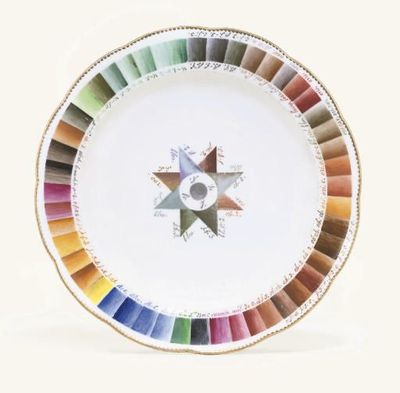

PERIOD: XVIIIeme
A SEVRES LOBED CIRCULAR 'INVENTAIRE' SOUP-PLATE CIRCA 1770, BLUE INTERLACED LS MARK, PAINTER'S VD. MARK FOR VANDE, INCISED LL MARK The centre painted with a grey circle enclosed by the script initials B. J. V. N. and an eight pointed star each point in a different shade of brown, green and blue with abbreviated names in script, the border painted with radiating bands showing forty-eight different shades of enamels with abbreviated names in script, gilt dentil rim (minor scratching to surface, some deterioration to glaze of four points of central star, slight wear to gilding) 9 3/8 in. (24 cm.) wide As un-fired colours frequently bore no relation to the colour produced when fired, artists at the factory would have made use of one or more 'inventory' palettes, such as this example. Even though the painter's would have kept and used their palettes throughout their working lives, few have survived, and S?vres inventory pieces are remarkably rare. The present lot appears to be the only known example with a gilt border. Two palette pieces are in the Mus?e National de C?ramique at S?vres; a teabowl decorated by Taunay fils in 1748, illustrated by Svend Eriksen and Geoffrey de Bellaigue, S?vres Porcelain, Vincennes and S?vres 1740-1800 (London, 1987), pl. A, and a documentary Vincennes teabowl inscribed ARmand Lain?e, ce 9 juillet 1749 by Louis-Denis Armand l'a?n?, sold by Sotheby's on the 22nd February 1988, lot 301. The present soup-plate was painted in circa 1770 by Jean-Baptiste-Emmanuel Vand? p?re, who was active at S?vres from 1753 to 1779 as a gilder, and later as a painter (he began his career as an oil painter, see Rosalind Savill, Catalogue of Sevres Porcelain [London, 1988], Vol. III, p. 1072). The shades Vand? chose for this palette were commonly used by painters, and the majority are the result of various combinations of tints. Some of the important colours (including red, violet and grey) are absent from this plate, which implies that Vand? must have presumably used this in conjunction with other (probably two) 'inventory' palettes. Most of the shades represented are identifiable from their abbreviations, and the four letters at the centre of the plate represent Noir, Bleu, Jaune and Vert. These are then further graded into various tones around the border of the plate, for instance the greens are graded V.-1., V-2., V.-3., V.-4., V.-5., V.-5p., and V.-6 or V.-G (for Vert Gay?), and the blues range from the darkest, B.-f., to the lightest, B.-C.. To produce such a shading of colours would have required years of experience and a very skilful hand. The carmin (pink) must have been bought from Salomon Taunay, as he was the exclusive supplier of this colour from 1744 (Taunay was also the author of the bowl in the Mus?e National de Ceramique, mentioned above, which included this colour). The ch stands for chatiron, the archaic name for dark brown; and the J.a for jaune ancien, colours which are still used at S?vres today. These are all couleurs ? peindre and were fired at a petit feu temperature of 750oC. For their names and chemical components, see Antoine d'Albis, Traite de la porcelaine de S?vres (Faton, 2003), pp.182 - 257. Considering that each colour involved more than half an hour of grinding, followed by blending and shading, the production of this kind of palette would have required at least a week of full time work. The glazes on four points of the central star (the grey matt colours) have deteriorated, and would not have originally been like this. (The deterioration could possibly have been caused by use with milk or vinegar, or sustained used with water). The green, inscribed v.d.S.ce, for Vert de Service, located between the black and blue (at 6 o'clock in the principal illustration) is apparently made from chromium, a metallic element which was only used from the 19th century onwards. S?vres pioneered the use of chromatic green in 1802, when the Director Alexandre Brongniart introduced it as a substitute for copper green. Antoine d'Albis has suggested that Vand? p?re would very probably have given the present palette to his son, Pierre-Jean-Baptiste, also a painter and gilder at S?vres from 1779 to 1824, who could have re-fired it with the new chromium green, which would explain the sanding on the reverse.
PRIX: $30000